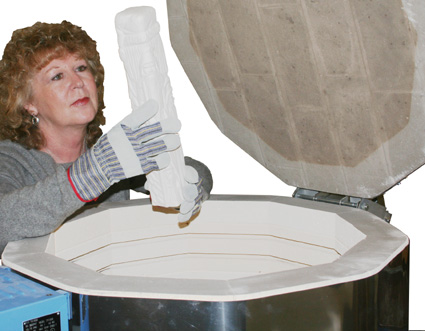 |
|
|
Kiln Pointers
|
|
|
How to Care for a Kiln Lid |
CONTENTS How to Care for a Kiln Lid Recent Q&As: Electrical shorts; the kiln switch box temperature A Kiln Story: In a Field to Itself Memorable Quote ----------- HOW TO CARE FOR A KILN LID First, handle the kiln lid as gently as you would a laptop computer. Slamming the lid can crack the bricks the first time it happens. Lids with a locking support arm: Fully disengage the arm before lowering the lid. Otherwise you can break the lid near the hinge. While loading and unloading the kiln, do not touch the lid support or lid chains. Lids with a spring counterbalance, and clamshell-style glass kilns: Hold the lid handle and guide the lid or kiln top until it is fully opened. If you let go of the handle too soon, the lid will slam back, damaging the bricks. If the front of the lid rises slightly during firing, do not place a weight such as a brick on top of the lid to hold it down. The weight will add stress to the firebricks near the lid hinge. Instead, adjust the hinge so the lid doesn’t rise. Occasionally vacuum the inner lid surface with the brush attachment of a vacuum cleaner. From time to time, check the condition of the lid support or spring system and the lid handle. Keep the lid closed when you are not using the kiln. This keeps dust out and prevents the lid from dropping while you are away. Do not store anything inside the kiln or on top. Please share this information with family members, students, school maintenance people, or anyone who will be near your kiln. ----------- RECENT Q&As Q. What are the most common causes of electrical shorts in a kiln? A. Electrical shorts are usually due to mistakes made while changing an element or other part. Examples: 1) pinching a wire under a screw when re-installing the control panel; 2) allowing the cordset to touch the side of a hot kiln; 3) leaving out the mushroom-style porcelain insulators that go under the element connectors; 4) forgetting to cut off the excess element ends when installing a new element; 5) using electrical tape inside the kiln’s control panel; and 6) not replacing loose connectors. Q. Is the temperature inside the kiln’s switch box higher than the ambient room temperature? A. Yes. The temperature inside the kiln's control panel is higher than the ambient room temperature. As a general rule, the room temperature, measured 3 feet from the electric kiln, should not exceed 110 degrees F. Use fans to lower the temperature. This simple solution works in even the hottest weather provided you have sufficient cross ventilation through open windows. ----------- A KILN STORY: IN A FIELD TO ITSELF When I first started working at Paragon, I had a supervisor named Mike Adams. One day he wanted to produce an ad with the headline “Paragon Kilns: In a field to itself.” To illustrate the ad, we shot a photo of kilns in a field next the factory. Mike and I laboriously carried kilns out to the field under the baking sun. To show a large variety, we carried big square kilns, 8-sided hobby kilns, and enameling kilns. Then we carefully polished the stainless cases and arranged the cord sets. The new kilns shimmered in the bright sun, and the stainless steel reflected the nearby grass. Mike fastened the big RB-67 Mamiya camera to a tripod, looked down into the viewfinder, and snapped rolls of film. Dripping with sweat, we carried the kilns back to the factory. The next day he processed the film in the Paragon darkroom. Sometimes on hot summer days like today, I think of that time when Mike and I covered that grassy field with Paragon kilns. ----------- MEMORABLE QUOTE “Every artist is a multi-media person. And clay is the most multi-media art of all. With clay you can draw, paint, print, do 3-D, 2-D, scratch, or solve chemistry, physics, and complex firing processes. One day I am a maker, the next I am a chemist . . . and the next a thermal dynamics engineer.” –Mel Jacobson, potter ----------- I have always loved reading. As a child, I often saw my parents reading. My father would lie on the couch after arriving home from work, an opened book in one hand and an apple in the other. My mother read and re-read books and underlined passages. I have updated our recommended book page. Have we left out your favorite titles? Would you like to write a book review? Let me know. www.paragonweb.com/Books_and_DVDs.cfm Thank you, With best wishes for an enjoyable summer, Arnold Howard Paragon Industries, L.P. – Better Designed Kilns 2011 South Town East Blvd., Mesquite, Texas 75149-1122 Voice: 972-288-7557 & 800-876-4328 / Fax: 972-222-0646 / ahoward@paragonweb.com / www.paragonweb.com / www.facebook.com/paragonkilns PRIVACY NOTICE: Under no circumstance do we share or sell your email address. Copyright 2010, by Paragon Industries, L.P. |
|
|

|
|
|
|
|
“Custom and standard Kilns and Industrial Furnaces for ceramics, pottery, heat treating, enameling, |
||||
